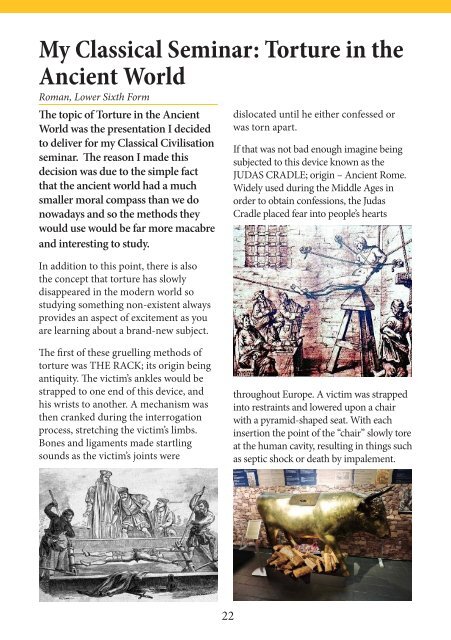Create successful ePaper yourself
Turn your PDF publications into a flip-book with our unique Google optimized e-Paper software.
My Classical Seminar: Torture in the<br />
Ancient World<br />
Roman, Lower Sixth Form<br />
The topic of Torture in the Ancient<br />
World was the presentation I decided<br />
to deliver for my Classical Civilisation<br />
seminar. The reason I made this<br />
decision was due to the simple fact<br />
that the ancient world had a much<br />
smaller moral compass than we do<br />
nowadays and so the methods they<br />
would use would be far more macabre<br />
and interesting to study.<br />
In addition to this point, there is also<br />
the concept that torture has slowly<br />
disappeared in the modern world so<br />
studying something non-existent always<br />
provides an aspect of excitement as you<br />
are learning about a brand-new subject.<br />
The first of these gruelling methods of<br />
torture was THE RACK; its origin being<br />
antiquity. The victim’s ankles would be<br />
strapped to one end of this device, and<br />
his wrists to another. A mechanism was<br />
then cranked during the interrogation<br />
process, stretching the victim’s limbs.<br />
Bones and ligaments made startling<br />
sounds as the victim’s joints were<br />
dislocated until he either confessed or<br />
was torn apart.<br />
If that was not bad enough imagine being<br />
subjected to this device known as the<br />
JUDAS CRADLE; origin – Ancient Rome.<br />
Widely used during the Middle Ages in<br />
order to obtain confessions, the Judas<br />
Cradle placed fear into people’s hearts<br />
throughout Europe. A victim was strapped<br />
into restraints and lowered upon a chair<br />
with a pyramid-shaped seat. With each<br />
insertion the point of the “chair” slowly tore<br />
at the human cavity, resulting in things such<br />
as septic shock or death by impalement.<br />
The closest thing to hell on earth may<br />
very well be the BRAZEN BULL; origin<br />
Ancient Greece. Made in bronze to<br />
look exactly like a bull, the structure<br />
was complete with a door on the bull’s<br />
abdomen through which a victim was<br />
forced. Once inside, the door was locked,<br />
and the statue was heated like a pot on a<br />
stove until the person was quite literally<br />
cooked to death.<br />
The HERETIC’S FORK originated<br />
from Medieval Spain and was used<br />
for confessions during the Spanish<br />
Inquisition, the heretic’s fork was even<br />
engraved with the Latin abiuro (“I<br />
recant”). Bi-pronged on both ends, the<br />
simple device was wedged painfully<br />
between the breastbone and the throat.<br />
The victim was unable to talk or fall<br />
asleep; unless they wished to be impaled,<br />
and delirium usually led to a confession.<br />
The next method here actually has an<br />
unknown origin, but I am sure that you<br />
would not want to be on the receiving<br />
end of RAT TORTURE. Despite the<br />
numerous approaches to rat torture,<br />
the most common was to start with a<br />
restrained victim. A rat was set on his<br />
body and covered by a container/cage.<br />
Heat was then applied, and the rat would<br />
desperately start clawing for a way out—<br />
and the only way was down through the<br />
body. The rat would dig and dig, slowly<br />
burrowing into the person until death.<br />
And, last but not least, was SAW<br />
TORTURE, originating from various parts<br />
of the ancient world. Everyone from the<br />
Persians to the Imperial Chinese practiced<br />
some form of death by sawing. Often the<br />
victim was hung upside down, thereby<br />
increasing blood flow to the head, and a<br />
large saw was placed between his legs. The<br />
executioners would slowly cut the person’s<br />
body in half, drawing out the process to<br />
make death as painful as possible.<br />
22 23


















